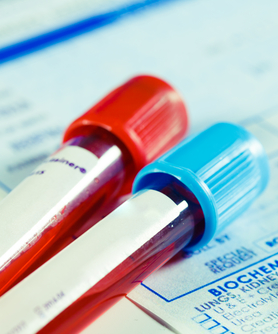Blood Draw Predicts Breast Cancer Relapse
Tracking tumor DNA in the blood of early breast cancer patients following surgery predicted relapse nearly 8 months earlier than conventional imaging.
Image © science photo / Shutterstock.com

Tracking tumor DNA in the blood of early breast cancer patients after surgery can detect relapse 7.9 months earlier than conventional imaging, according to the results of a study published in Science Translational Medicine.
Using a non-invasive circulating tumor DNA (ctDNA) analysis, Isaac Garcia-Murillas, PhD, of the Institute of Cancer Research in London, and colleagues tracked breast tumor–specific mutations in 55 patients who had undergone surgery and chemotherapy as a potentially curative treatment. The results of the prospective study suggest that patients at risk for relapse may be identified earlier and given more aggressive treatment to prevent metastasis.
Of the 15 patients who relapsed on study, the presence of ctDNA predicted the relapse of 12 patients. Among the patients who did not relapse, 96% had no detectable ctDNA in either the post-surgery sample (24 of 25; P = .0038) or during temporal tracking of tumor mutations (27 of 28; P < .0001). One patient, with triple-negative disease, had detectable ctDNA after surgery but did not relapse on study.
All metastatic tumors were detectable by ctDNA except for three patients who had recurrence in the brain.
The study also showed that ctDNA analysis could identify the genetic events that define minimal residual disease among breast cancer patients. This genetic analysis of minimal residual disease also predicted the genetics of the relapsed tumor better than sequencing analysis of the primary breast tumor. The study authors concluded that tracking of ctDNA linked to cancer relapse could facilitate the tailoring of adjuvant therapies based on the mutations captured in patients’ blood samples.
The utility of ctDNA analysis in late-stage cancer patients has already been demonstrated in previous research studies, although the technique is not yet ready to be used in the clinical setting. The current study, however, is among the first to demonstrate the ability to capture ctDNA from blood samples of earlier stage cancer patients. Tumor DNA circulates in the blood in minute amounts, and whether these molecules can be consistently detected using current technologies has been an open question.
Garcia-Murillas and his colleagues first sequenced each patient’s primary tumor, identifying tumor-specific somatic mutations to track in the ctDNA following surgery. ctDNA detected at baseline, prior to any therapy, was not associated with early relapse. ctDNA detected at 2 to 4 weeks after surgery was indicative of early relapse-those who had detectable ctDNA (19%; 7 of 37 patients) had a median disease-free survival (DFS) of 6.5 months; median DFS among patients with no detectable ctDNA was not reached.
“In addition to confirming the feasibility of ctDNA detection in non-metastatic breast cancer, Garcia-Murillas et al have extended these findings in a prospective study, demonstrating that longitudinal monitoring of ctDNA is more reliable than single baseline measurements in predicting recurrence in women treated with neoadjuvant chemotherapy for localized breast cancer,” stated Tilak Sundaresan, MD, and Daniel Haber, MD, PhD, of the Massachusetts General Hospital Cancer Center in Boston, in an accompanying editorial.